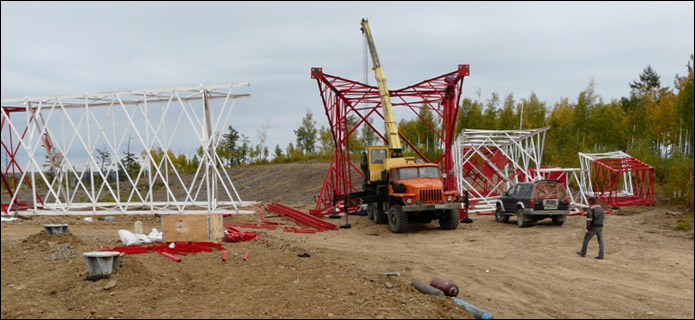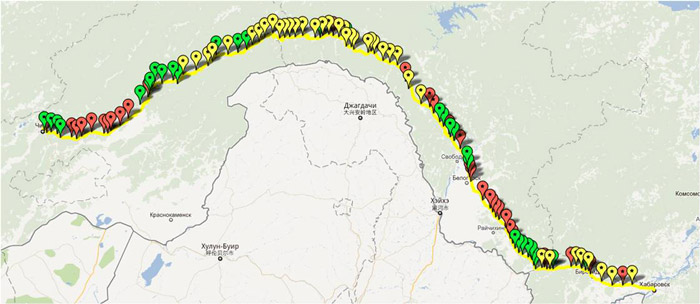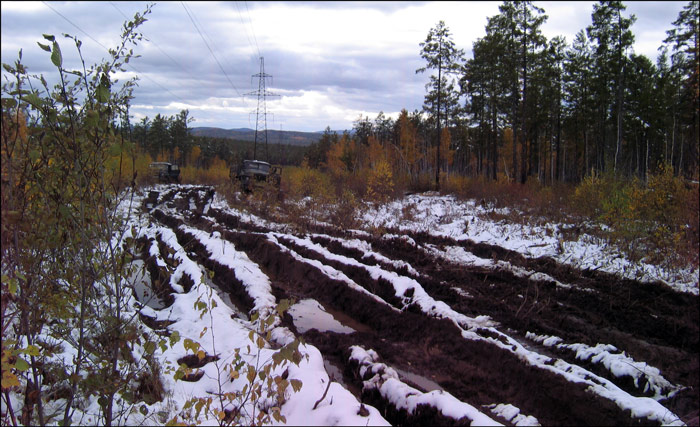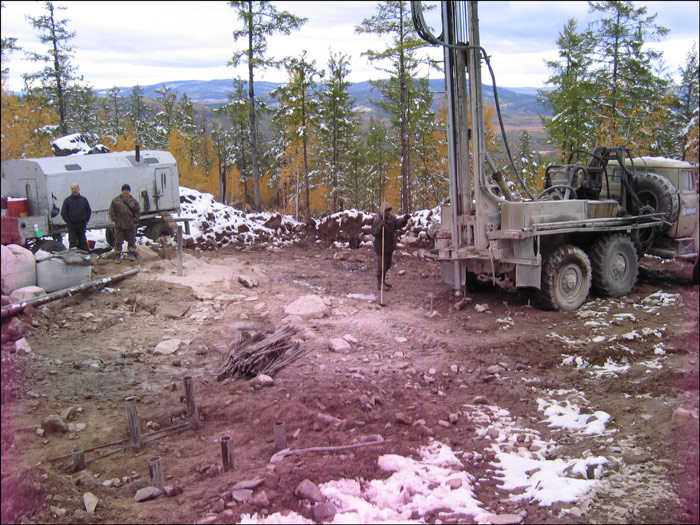How we built a mobile network on the “Amur” highway: telephone installation in the country and no nails!
In the topic I will talk about the largest telecommunications project in recent years, which turned out to be amazing in terms of implementation.

The project of building a mobile network on the “Amur” highway has 4 important differences from all that we have done before:
')
After the Chairman of the Government of the Russian Federation drove on the “Kalina” along the M58 “Amur” highway, all three operators started to fairly quickly deploy the infrastructure on it. We worked in an emergency mode day and night, blew up passages for cable channels, brought up, mounted and configured iron and laid out to the fullest. After all the work done, I, my colleagues and our friends from the states of other operators can only be proud of how really cool we have worked together.
The fact is that if you drove there, you would have noticed that for hundreds of kilometers the phone did not “see” the signal of the cellular network of any of the operators. Clearly, for a major federal highway, this is not a good situation that required change. On August 30, 2010, at a meeting on road construction in Chita, the Chairman of the Government of the Russian Federation set the task of equipping the M58 Chita-Khabarovsk highway (Amur highway) with a mobile radiotelephone connection with completion in September 2011.

Track
At that time, the route coverage by the networks of the Big Three operators was: VimpelCom - 39%, MTS - 56%, Megaphone - 60% (according to RFTC with a measurement level of -100 dBm). The fact is that at the time of the project implementation, MTS and MegaFon already had GSM 900 licenses on the territory of all three constituent entities of the Russian Federation, along which the Amur route runs (Trans-Baikal Territory, Amur Region, Jewish Autonomous Region), and Beeline had only 3G licenses in the territory of the Trans-Baikal Territory and the JAR and GSM 1800 in the Amur Region.
It's time to bring a small geographical reference. The federal highway Chita - Khabarovsk passes through the territories of three constituent entities of the Russian Federation, the total length of the route is 2,165 km. To understand the global nature of the task, let me remind you that the distance from Moscow to Berlin is only 1.606 km (or 1.820 kilometers along the highway).
Understanding the global nature of the task, prompted the Big Three operators to take an unprecedented step, namely, to make a decision on the equal cost sharing for the construction of network infrastructure. If everywhere in the country each of the operators has their own sites and their own hardware, here common platforms agreed by the standard were used as the base. This decision allowed to reduce investment in the project of each of the participants by more than one and a half times. In general, this is an amazing case when each of the operators really began to work closely with the others, which until this moment was considered incredible for the domestic market.
After determining the targeted construction program for antenna-mast structures, the definition and coordination of which was carried out with the participation of the planners of the three companies, the scope of work assigned to each of the parties was determined. In order to organize 100% of the route coverage by networks of three operators, it was necessary to install 102 towers in addition to the existing positions, of which 38 were in VimpelCom’s area of responsibility, 32 were MTS and Megaphone also 32. To ensure full coverage of the route, operators had to launch 283 basic stations, of which 101 BS - VimpelCom, 91 - MTS, 91 - Megaphone.

Yellow - our sites (Beeline), green - Megaphone, red - MTS.
The only technological solution that would quickly organize transportation along the highway was the construction of a transport network based on the radio relay communication principle (RRL equipment). In this direction, the principle of inter-operator cooperation was also achieved, based on the division of the backbone transport network into 3 segments defined by geography. Each segment is in the area of responsibility of the relevant operator. The complex of measures for planning, construction and integration of radio relay links within its cluster, each operator carried out independently, based on the agreed technical requirements and principles of organization of communication channels. I will give the main provisions of this agreement:
• Ability to transmit both packet traffic and TDM traffic
• Minimum bandwidth of 150 Mbit / s RRL in one polarization
• On the trunk RRL 3 tunnels 50 Mb wide are organized for each operator
The project was coordinated directly by the Ministry of Communications and Mass Media of Russia with the involvement of government agencies that assisted in the allocation of land and forest land and the construction of access roads. The provision of power supply to the facilities was entrusted to JSC RAO ES of the East, JSC IDGC of Siberia, JSC FGC UES and JSC Russian Railways. The project budget amounted to 4.7 billion rubles, of which approximately 2.4 were used by the Big Three operators to erect telecommunication facilities, and 2.3 were allocated by the state to provide power supply and build access roads to the facilities.
The foundation of the first tower of Beeline under the Amur project was laid on April 22, 2011 with the participation of Deputy Minister of Communications N.S. Mardera in Ol settlement (Jewish Autonomous Region). It is symbolic that this very object of VimpelCom OJSC became the first broadcast station of the Amur project, and it was there that the videoconferencing of the Minister of Communications and Mass Communications of the Russian Federation Igor Schegolev and the Deputy Chairman of the Government of the Russian Federation Sergey Ivanov was organized in October.
Construction of such a number of facilities literally in 4 months (the main phase of construction started only at the end of May) was a non-trivial task, primarily because of the weak development of the energy and transport infrastructure in the region, the need to build long access roads. The total length of access roads to communication facilities built by operators is more than 100 kilometers, and the length of the last mile of power engineering exceeds 500 kilometers.

Track

New base station
So, at one of the VimpelCom positions (234th kilometer) in the Jewish Autonomous Region, to install a tower on the top of a hill located 200 meters from the Amur highway, it was necessary to lay a serpentine road with a total length of 3.5 kilometers in the rocky ground, where it took not only to cut down and remove the forest along the entire length of the road, but also to carry out blasting operations. I never thought that Beeline would be involved in mining and sinking, but I had to.
In the Amur region had to work with the installation of a base station in the village of Orochensky. For the construction of the access road to the location of the BS also conducted explosive work. The launch of the position of Krasnaya Pad in the Amur Region was generally carried out in absolutely record time: from the moment of obtaining a building permit to the moment of launch only 1 month passed! During this time, a forest was cut down on the position, an access road was built, the foundation was poured, the AMC was mounted 70 meters high, and the equipment was integrated.

Zhanna-Chichatka: Russian road

Zhanna-Chichatka: the beginning of construction

Ol, bookmark

Installation of BS on Nyukzha

Olha, hardware
Difficulties were associated with enormous distances. For example, the distance between the extreme Beeline BSs in the Amur Region is more than 1000 kilometers (from Ayyachi on the border of the Trans-Baikal Territory and the Amur Region to Kazachi on the border of the Jewish Autonomous Region). Despite this, in the last weeks of September, it was possible to launch up to 30 BS per week, primarily due to the actual round-the-clock work of contractors and employees of our company's branches.
It is necessary to note the employees of the transport network operation department. The guys, having received absolutely new RRL equipment and having only documentation and software, independently figured out, configured, prescribed routing of the entire transport network on the new hardware along the entire section in the VimpelCom area of responsibility, since the time to attract qualified specialists from the supplier ( done under normal conditions) just was not. If there are integrators among readers, then you will perfectly understand how difficult this task is.
September 15 - 3 BS on the air
September 19 - 7 BS on the air
September 23 - 13 BS on the air
September 28 - 22 BS on the air
September 30 - already 46 BS on the air
October 2 - more than 70 BS on the air
October 4 - 84 BS on the air
Of course, not all the work was completed exactly by the first of October, as originally planned. So, for example, half of the positions are still working according to the temporary power supply scheme through the installed diesel generator sets - electricity, such facilities, need to be driven several tens of kilometers. I can state quite unequivocally that with the Big Three operators, maximum efforts were made, if not to say super efforts, in order to achieve such a result.
If we talk about the social significance of the project, then in addition to organizing communications throughout the entire route, it should be noted that there are more than 100 settlements adjacent to the route, in which more than 150 thousand people live. At the same time, 50 villages were generally telephone for the first time. Providing radio coverage throughout the Amur highway allows accelerating the development of roadside infrastructure and significantly improving the convenience and safety of the highway for road users. In addition to voice communications, as a result of the project, residents of the territories adjacent to the highway were able to use high-speed Internet access using 3G technology.
On October 3, 2011, Igor Shchegolev visited the federal highway and traveled from Khabarovsk to Blagoveshchensk, personally checking the results of fulfilling the instructions of the Chairman of the Government of the Russian Federation using his mobile phone. As it turned out during the trip, the minister uses the communication services of our company, therefore, the results of the work done, I’m not afraid of this word, Mr. Shchegolev judged the colossal work by covering the Beeline network. Igor O. remained completely satisfied with the result, which he personally personally reported to Vladimir Vladimirovich Putin.
“Full coverage of the Amur highway by mobile communication brings the Far East closer to European standards for the availability of telecommunications services. Modernization of the transport and telecommunications infrastructure is in full swing, not only in the European part, but also in the east of the country. Uniform development of information infrastructure, the elimination of digital inequality - priority tasks. This project is a successful experience of private-state partnership in creating infrastructure in sparsely populated and hard-to-reach regions of the country, ”said the Minister of Communications and Mass Communications of the Russian Federation Igor Shchegolev.
PS Yes, the topic looks like the news from the times of the Soviet Union about the construction of BAM, the first man’s exit into space or something similar. And - yes, for us it really is almost the same great achievement. We had a very difficult and almost incredible project, and we managed. It is very inspiring.

The project of building a mobile network on the “Amur” highway has 4 important differences from all that we have done before:
- First, the project is inhumanly voluminous.
- Secondly, it was performed in record time.
- Thirdly, the most modern equipment was used for it.
- And fourthly, all operators of the Big Three were able to work side by side, which is in itself a great event.
')
It all started with the Soviet automobile industry
After the Chairman of the Government of the Russian Federation drove on the “Kalina” along the M58 “Amur” highway, all three operators started to fairly quickly deploy the infrastructure on it. We worked in an emergency mode day and night, blew up passages for cable channels, brought up, mounted and configured iron and laid out to the fullest. After all the work done, I, my colleagues and our friends from the states of other operators can only be proud of how really cool we have worked together.
The fact is that if you drove there, you would have noticed that for hundreds of kilometers the phone did not “see” the signal of the cellular network of any of the operators. Clearly, for a major federal highway, this is not a good situation that required change. On August 30, 2010, at a meeting on road construction in Chita, the Chairman of the Government of the Russian Federation set the task of equipping the M58 Chita-Khabarovsk highway (Amur highway) with a mobile radiotelephone connection with completion in September 2011.

Track
Situation at the beginning of the project
At that time, the route coverage by the networks of the Big Three operators was: VimpelCom - 39%, MTS - 56%, Megaphone - 60% (according to RFTC with a measurement level of -100 dBm). The fact is that at the time of the project implementation, MTS and MegaFon already had GSM 900 licenses on the territory of all three constituent entities of the Russian Federation, along which the Amur route runs (Trans-Baikal Territory, Amur Region, Jewish Autonomous Region), and Beeline had only 3G licenses in the territory of the Trans-Baikal Territory and the JAR and GSM 1800 in the Amur Region.
It's time to bring a small geographical reference. The federal highway Chita - Khabarovsk passes through the territories of three constituent entities of the Russian Federation, the total length of the route is 2,165 km. To understand the global nature of the task, let me remind you that the distance from Moscow to Berlin is only 1.606 km (or 1.820 kilometers along the highway).
First great collaboration
Understanding the global nature of the task, prompted the Big Three operators to take an unprecedented step, namely, to make a decision on the equal cost sharing for the construction of network infrastructure. If everywhere in the country each of the operators has their own sites and their own hardware, here common platforms agreed by the standard were used as the base. This decision allowed to reduce investment in the project of each of the participants by more than one and a half times. In general, this is an amazing case when each of the operators really began to work closely with the others, which until this moment was considered incredible for the domestic market.
After determining the targeted construction program for antenna-mast structures, the definition and coordination of which was carried out with the participation of the planners of the three companies, the scope of work assigned to each of the parties was determined. In order to organize 100% of the route coverage by networks of three operators, it was necessary to install 102 towers in addition to the existing positions, of which 38 were in VimpelCom’s area of responsibility, 32 were MTS and Megaphone also 32. To ensure full coverage of the route, operators had to launch 283 basic stations, of which 101 BS - VimpelCom, 91 - MTS, 91 - Megaphone.

Yellow - our sites (Beeline), green - Megaphone, red - MTS.
Connection
The only technological solution that would quickly organize transportation along the highway was the construction of a transport network based on the radio relay communication principle (RRL equipment). In this direction, the principle of inter-operator cooperation was also achieved, based on the division of the backbone transport network into 3 segments defined by geography. Each segment is in the area of responsibility of the relevant operator. The complex of measures for planning, construction and integration of radio relay links within its cluster, each operator carried out independently, based on the agreed technical requirements and principles of organization of communication channels. I will give the main provisions of this agreement:
• Ability to transmit both packet traffic and TDM traffic
• Minimum bandwidth of 150 Mbit / s RRL in one polarization
• On the trunk RRL 3 tunnels 50 Mb wide are organized for each operator
Official part
The project was coordinated directly by the Ministry of Communications and Mass Media of Russia with the involvement of government agencies that assisted in the allocation of land and forest land and the construction of access roads. The provision of power supply to the facilities was entrusted to JSC RAO ES of the East, JSC IDGC of Siberia, JSC FGC UES and JSC Russian Railways. The project budget amounted to 4.7 billion rubles, of which approximately 2.4 were used by the Big Three operators to erect telecommunication facilities, and 2.3 were allocated by the state to provide power supply and build access roads to the facilities.
The foundation of the first tower of Beeline under the Amur project was laid on April 22, 2011 with the participation of Deputy Minister of Communications N.S. Mardera in Ol settlement (Jewish Autonomous Region). It is symbolic that this very object of VimpelCom OJSC became the first broadcast station of the Amur project, and it was there that the videoconferencing of the Minister of Communications and Mass Communications of the Russian Federation Igor Schegolev and the Deputy Chairman of the Government of the Russian Federation Sergey Ivanov was organized in October.
As we blew and took out
Construction of such a number of facilities literally in 4 months (the main phase of construction started only at the end of May) was a non-trivial task, primarily because of the weak development of the energy and transport infrastructure in the region, the need to build long access roads. The total length of access roads to communication facilities built by operators is more than 100 kilometers, and the length of the last mile of power engineering exceeds 500 kilometers.

Track

New base station
So, at one of the VimpelCom positions (234th kilometer) in the Jewish Autonomous Region, to install a tower on the top of a hill located 200 meters from the Amur highway, it was necessary to lay a serpentine road with a total length of 3.5 kilometers in the rocky ground, where it took not only to cut down and remove the forest along the entire length of the road, but also to carry out blasting operations. I never thought that Beeline would be involved in mining and sinking, but I had to.
In the Amur region had to work with the installation of a base station in the village of Orochensky. For the construction of the access road to the location of the BS also conducted explosive work. The launch of the position of Krasnaya Pad in the Amur Region was generally carried out in absolutely record time: from the moment of obtaining a building permit to the moment of launch only 1 month passed! During this time, a forest was cut down on the position, an access road was built, the foundation was poured, the AMC was mounted 70 meters high, and the equipment was integrated.

Zhanna-Chichatka: Russian road

Zhanna-Chichatka: the beginning of construction

Ol, bookmark

Installation of BS on Nyukzha

Olha, hardware
Difficulties were associated with enormous distances. For example, the distance between the extreme Beeline BSs in the Amur Region is more than 1000 kilometers (from Ayyachi on the border of the Trans-Baikal Territory and the Amur Region to Kazachi on the border of the Jewish Autonomous Region). Despite this, in the last weeks of September, it was possible to launch up to 30 BS per week, primarily due to the actual round-the-clock work of contractors and employees of our company's branches.
It is necessary to note the employees of the transport network operation department. The guys, having received absolutely new RRL equipment and having only documentation and software, independently figured out, configured, prescribed routing of the entire transport network on the new hardware along the entire section in the VimpelCom area of responsibility, since the time to attract qualified specialists from the supplier ( done under normal conditions) just was not. If there are integrators among readers, then you will perfectly understand how difficult this task is.
Five years - in three years!
September 15 - 3 BS on the air
September 19 - 7 BS on the air
September 23 - 13 BS on the air
September 28 - 22 BS on the air
September 30 - already 46 BS on the air
October 2 - more than 70 BS on the air
October 4 - 84 BS on the air
Of course, not all the work was completed exactly by the first of October, as originally planned. So, for example, half of the positions are still working according to the temporary power supply scheme through the installed diesel generator sets - electricity, such facilities, need to be driven several tens of kilometers. I can state quite unequivocally that with the Big Three operators, maximum efforts were made, if not to say super efforts, in order to achieve such a result.
Bright and sudden future in the villages
If we talk about the social significance of the project, then in addition to organizing communications throughout the entire route, it should be noted that there are more than 100 settlements adjacent to the route, in which more than 150 thousand people live. At the same time, 50 villages were generally telephone for the first time. Providing radio coverage throughout the Amur highway allows accelerating the development of roadside infrastructure and significantly improving the convenience and safety of the highway for road users. In addition to voice communications, as a result of the project, residents of the territories adjacent to the highway were able to use high-speed Internet access using 3G technology.
Final acceptance
On October 3, 2011, Igor Shchegolev visited the federal highway and traveled from Khabarovsk to Blagoveshchensk, personally checking the results of fulfilling the instructions of the Chairman of the Government of the Russian Federation using his mobile phone. As it turned out during the trip, the minister uses the communication services of our company, therefore, the results of the work done, I’m not afraid of this word, Mr. Shchegolev judged the colossal work by covering the Beeline network. Igor O. remained completely satisfied with the result, which he personally personally reported to Vladimir Vladimirovich Putin.
“Full coverage of the Amur highway by mobile communication brings the Far East closer to European standards for the availability of telecommunications services. Modernization of the transport and telecommunications infrastructure is in full swing, not only in the European part, but also in the east of the country. Uniform development of information infrastructure, the elimination of digital inequality - priority tasks. This project is a successful experience of private-state partnership in creating infrastructure in sparsely populated and hard-to-reach regions of the country, ”said the Minister of Communications and Mass Communications of the Russian Federation Igor Shchegolev.
PS Yes, the topic looks like the news from the times of the Soviet Union about the construction of BAM, the first man’s exit into space or something similar. And - yes, for us it really is almost the same great achievement. We had a very difficult and almost incredible project, and we managed. It is very inspiring.
Source: https://habr.com/ru/post/132912/
All Articles